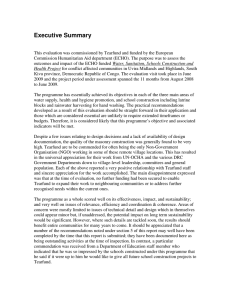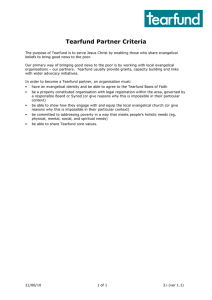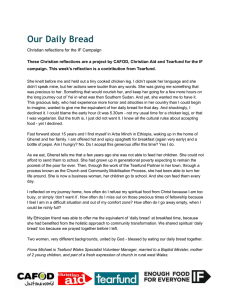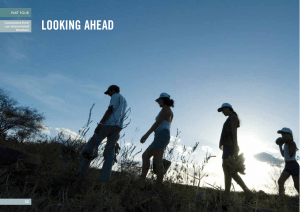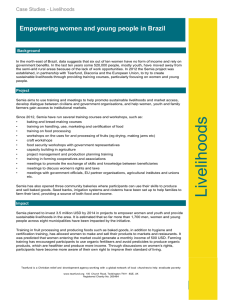Executive Summary
advertisement
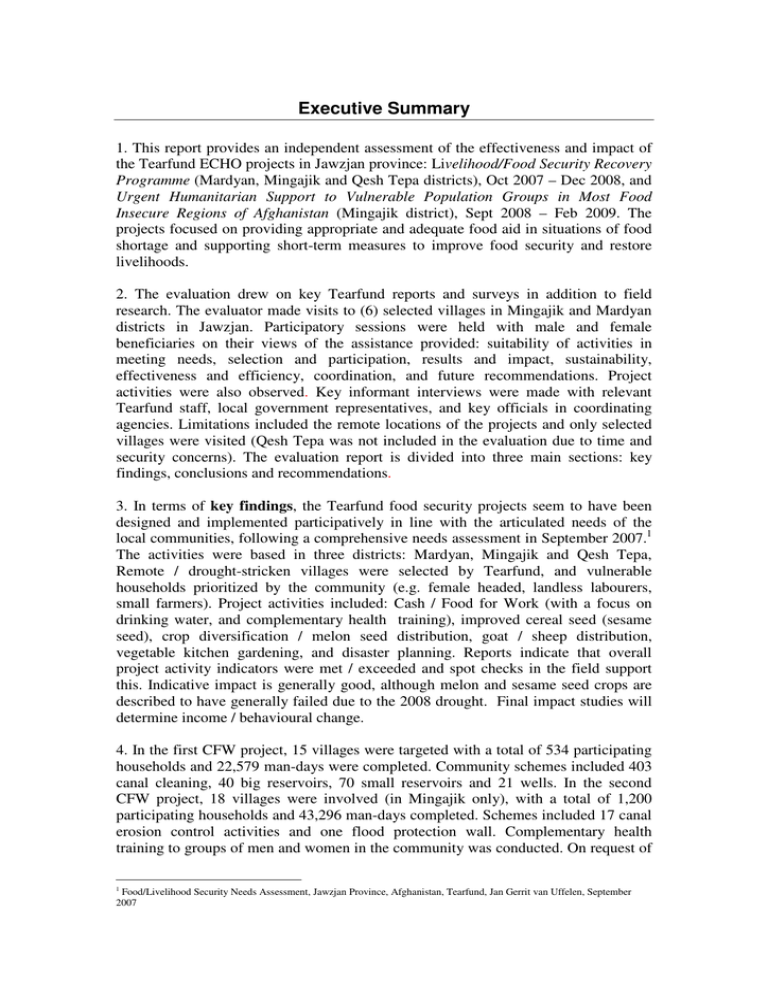
Executive Summary 1. This report provides an independent assessment of the effectiveness and impact of the Tearfund ECHO projects in Jawzjan province: Livelihood/Food Security Recovery Programme (Mardyan, Mingajik and Qesh Tepa districts), Oct 2007 – Dec 2008, and Urgent Humanitarian Support to Vulnerable Population Groups in Most Food Insecure Regions of Afghanistan (Mingajik district), Sept 2008 – Feb 2009. The projects focused on providing appropriate and adequate food aid in situations of food shortage and supporting short-term measures to improve food security and restore livelihoods. 2. The evaluation drew on key Tearfund reports and surveys in addition to field research. The evaluator made visits to (6) selected villages in Mingajik and Mardyan districts in Jawzjan. Participatory sessions were held with male and female beneficiaries on their views of the assistance provided: suitability of activities in meeting needs, selection and participation, results and impact, sustainability, effectiveness and efficiency, coordination, and future recommendations. Project activities were also observed. Key informant interviews were made with relevant Tearfund staff, local government representatives, and key officials in coordinating agencies. Limitations included the remote locations of the projects and only selected villages were visited (Qesh Tepa was not included in the evaluation due to time and security concerns). The evaluation report is divided into three main sections: key findings, conclusions and recommendations. 3. In terms of key findings, the Tearfund food security projects seem to have been designed and implemented participatively in line with the articulated needs of the local communities, following a comprehensive needs assessment in September 2007.1 The activities were based in three districts: Mardyan, Mingajik and Qesh Tepa, Remote / drought-stricken villages were selected by Tearfund, and vulnerable households prioritized by the community (e.g. female headed, landless labourers, small farmers). Project activities included: Cash / Food for Work (with a focus on drinking water, and complementary health training), improved cereal seed (sesame seed), crop diversification / melon seed distribution, goat / sheep distribution, vegetable kitchen gardening, and disaster planning. Reports indicate that overall project activity indicators were met / exceeded and spot checks in the field support this. Indicative impact is generally good, although melon and sesame seed crops are described to have generally failed due to the 2008 drought. Final impact studies will determine income / behavioural change. 4. In the first CFW project, 15 villages were targeted with a total of 534 participating households and 22,579 man-days were completed. Community schemes included 403 canal cleaning, 40 big reservoirs, 70 small reservoirs and 21 wells. In the second CFW project, 18 villages were involved (in Mingajik only), with a total of 1,200 participating households and 43,296 man-days completed. Schemes included 17 canal erosion control activities and one flood protection wall. Complementary health training to groups of men and women in the community was conducted. On request of 1 Food/Livelihood Security Needs Assessment, Jawzjan Province, Afghanistan, Tearfund, Jan Gerrit van Uffelen, September 2007 the MAIL, the goat distribution was postponed to June and July 2008. A total of 15 villages participated in this activity and 150 vulnerable households received the initial 5 goats after agreement to the repayment scheme. Tearfund then coordinated with a local veterinarian to organise animal vaccinations. Fifteen villages were targeted for sesame seed distribution. Farmers (1300) received 6kg seeds to cultivate a maximum of 3 jeribs. Thirteen villages were targeted for the kitchen garden project, and around 400 households received training and inputs (5 packets of seeds and water can). Fifteen villages were targeted for the melon seed, and 400 farmers received 2kg of melon seed. Finally, eighteen villages were selected for community level disaster planning training and establishment of male and female PADR (‘bedari) committees. 5. In general, Tearfund ECHO projects were well targeted in terms of districts, communities and households selected, and activities were appropriate for strengthening coping strategies and enhancing food availability. This was largely due to comprehensive survey work prior to / during the project, and good coordination / consultation / exchange with local actors (government, NGOs and local structures). Communities were shown to have participated in all project phases: planning, design and implementation. Both communities and MRRD described how these projects (particularly the CFW) had curbed some migration in reducing vulnerability through the boosting of incomes of desperate households. Communities also described crucial skills learnt including health tips, kitchen gardening, goat rearing, and disaster planning / problem solving (the latter was much appreciated). Overall the projects were effective and objectives were largely met (except for the crop activities). The perception of Tearfund seemed to be excellent at the community level and amongst stakeholders. The F/CFW projects were very effective in particular in immediately boosting incomes of vulnerable families. Both staff and beneficiaries indicate that activities seem to have been implemented efficiently (costs, time and resources). Where possible, Tearfund sources project materials / inputs locally. Tearfund has tried to ensure the sustainability of (short-term) community interventions, although longerterm farm and off-farm projects would evidently have a greater impact on food security / livelihoods. In the course of the project, Tearfund has managed to build up excellent relations with the local communities / local CDCs, local authorities (MRRD, DMC and MAIL) and other NGOs through close coordination, exchange, and transparency / accountability (Action Aid and ZOA in particular). Local NGOs (JDA) were subcontracted for some of the training, and this has worked well. Although Tearfund has faced some threats and operational challenges (and been forced to relocate expatriate staff in Aqcha), this seems to be linked to anti-government elements and poverty, rather than poor local relations. Internal Tearfund interactions seem good. 6. In the second section, the report describes the main conclusions from the evaluation. In general, the project targeted vulnerable districts, communities and households well. Project activities were appropriate and generally met basic needs. Stakeholders were involved in participative planning, design, implementation and evaluation, and Tearfund was generally accountable / transparent in their activities, Interventions strengthened coping strategies through immediate relief and increasing capacities and skills but community needs remain high. Project processes and activities endeavoured to include women where possible, but women are desperate for more diversified income generating activities (and support to carpet and embroidery enterprises). New community bodies created (such as the ‘bedari’) need to be better linked to existing structures (i.e. CDCs) to enhance their ongoing role and sustainability. Meanwhile, interventions in agriculture need to consider ongoing sustainability of initiatives in terms of access to products and services (e.g. vet services), and market links. The impact of future interventions needs to be considered in terms of both positive and negative impact on the local market. Whilst CFW projects have been appreciated and useful, community / local infrastructure requires significant upgrading (water, roads and power). In general, the project proceeded as planned, although the insecure regional context has created some operational challenges. The future design of interventions should endeavour to build off best practice in Afghanistan to enhance effectiveness of community-based activities (e.g. kitchen garden projects and food processing components (see FAO and Afghanaid)). Future interventions need to consider creative joint agency collaboration (to maximise organisational strengths and project results). Finally, an end of project impact survey is now required to assess project effectiveness. 7. The last section of the report presents immediate and future recommendations for Tearfund. Points for immediate action include the need to link community disaster planning committees (‘bedari’) to CDCs, and to carry out a project impact survey. Meanwhile, points to consider in future planning include: • • • • • • • • Longer-term interventions required to support livelihoods with links to the market; Establishment of producer groups, and support for value chain development; Establishment of Self Help Groups (Savings / Credit Groups) (for women / poorer groups); Strategise with communities to improve access to products and services; Analyse regional context to minimise threats / operational challenges; Explore innovative solutions to improve infrastructure (water, roads, power); Review and draw on best practice in Afghanistan in community-based activities; Explore joint agency collaboration at the community level. Email kyb@tearfund.org for full report.
